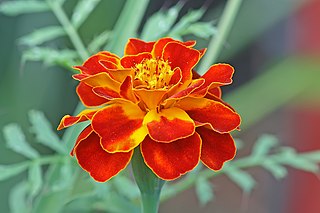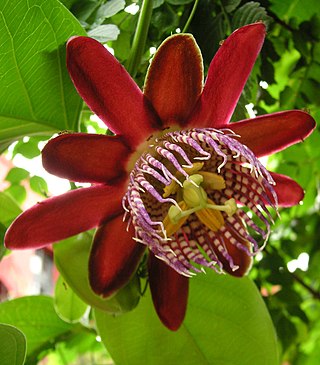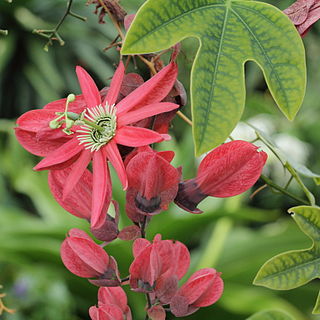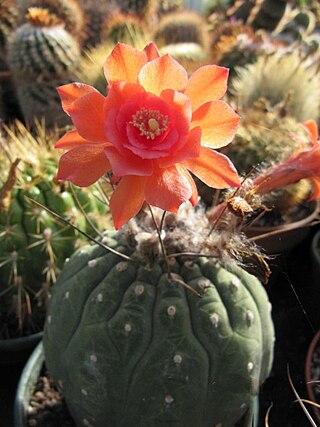
Pilosella aurantiaca is a perennial flowering plant in the family Asteraceae that is native to alpine regions of central and southern Europe, where it is protected in several regions.

Alstroemeria, commonly called the Peruvian lily or lily of the Incas, is a genus of flowering plants in the family Alstroemeriaceae. They are all native to South America, although some have become naturalized in the United States, Mexico, Australia, New Zealand, Madeira and the Canary Islands. Almost all of the species are restricted to one of two distinct centers of diversity; one in central Chile, the other in eastern Brazil. Species of Alstroemeria from Chile are winter-growing plants, while those of Brazil are summer growing. All are long-lived perennials except A. graminea, a diminutive annual from the Atacama Desert of Chile.

Fritillaria meleagris is a Eurasian species of flowering plant in the lily family Liliaceae. Its common names include snake's head fritillary, snake's head, chess flower, frog-cup, guinea-hen flower, guinea flower, leper lily, Lazarus bell, chequered lily, chequered daffodil, drooping tulip or, in the British Isles, simply fritillary. The plant is a bulbous perennial native to the flood river plains of Europe where it grows in abundance.

Impatiens walleriana, also known as busy Lizzie, balsam, sultana, or simply impatiens, is a species of the genus Impatiens, native to eastern Africa from Kenya to Mozambique. The Latin specific epithet walleriana honours a British missionary, Horace Waller (1833–1896).

Primula vulgaris, the common primrose, is a species of flowering plant in the family Primulaceae, native to western and southern Europe, northwest Africa, and parts of southwest Asia. The common name is primrose, or occasionally common primrose or English primrose to distinguish it from other Primula species also called primroses. None of these are closely related to the evening primroses.

Lobularia maritima is a species of low-growing flowering plant in the family Brassicaceae. Its common name is sweet alyssum or sweet alison, also commonly referred to as just alyssum.

Tagetes patula, the French marigold, is a species of flowering plant in the family Asteraceae, native to Mexico and Guatemala with several naturalised populations in many other countries. It is widely cultivated as an easily grown bedding plant, with thousands of different cultivars in brilliant shades of yellow and orange.

Celosia argentea, commonly known as the plumed cockscomb or silver cock's comb, is a herbaceous plant of tropical origin in the Amaranthaceae family from India and Nepal. The plant is known for its very bright colors. In India and China it is known as a troublesome weed.

Dasylirion wheeleri is a species of flowering plant in the asparagus family (Asparagaceae), native to arid environments of northern Mexico and the southwestern United States.

Lavandula angustifolia, formerly L. officinalis, is a flowering plant in the family Lamiaceae, native to the Mediterranean. Its common names include lavender, true lavender and English lavender ; also garden lavender, common lavender and narrow-leaved lavender.

Vinca major, with the common names bigleaf periwinkle, large periwinkle, greater periwinkle and blue periwinkle, is a species of flowering plant in the family Apocynaceae, native to the western Mediterranean. Growing to 25 cm (10 in) tall and spreading indefinitely, it is an evergreen perennial, frequently used in cultivation as groundcover.

Cenolophium is a genus of flowering plants in the carrot family Apiaceae (Umbelliferae). Its only species is Cenolophium denudatum, native to Europe and Asia. A herbaceous perennial, it grows to 1.5 m (4.9 ft) tall by 0.5 m (1.6 ft) wide, with dark green divided leaves and, in summer, many umbels of tiny pale green or white flowers on branching naked stems. The stems are sometimes purple in colour. The flowers are attractive to numerous insects.

Passiflora alata, the winged-stem passion flower, is a species of flowering plant. It is an evergreen vine, growing to 6 m (20 ft) or more, which bears an edible type of passion fruit. It is native to the Amazon, from Peru to eastern Brazil.

Symphyotrichum lateriflorum is a species of flowering plant in the aster family (Asteraceae). Commonly known as calico aster, starved aster, and white woodland aster, it is native to eastern and central North America. It is a perennial and herbaceous plant that may reach heights up to 120 centimeters and widths up to 30 centimeters.

Phlox paniculata is a species of flowering plant in the phlox family (Polemoniaceae). It is native to parts of the eastern and central United States. It is extensively cultivated in temperate regions as an ornamental plant and has become established in the wild in scattered locales in other regions. Common names include fall phlox, garden phlox, perennial phlox, summer phlox, and panicled phlox.

Erysimum cheiri, syn. Cheiranthus cheiri, the wallflower, is a species of flowering plant in the family Brassicaceae (Cruciferae), native to Greece, but widespread as an introduced species elsewhere. It is also treated as a hybrid under the name Erysimum × cheiri. It is widely cultivated as a garden plant.

Primula denticulata, the drumstick primula, is a species of flowering plant in the family Primulaceae, native to moist alpine regions of China, Afghanistan, Bhutan, India, N Myanmar, Nepal, and Pakistan. It is an herbaceous perennial growing to 45 cm (18 in) tall and wide, with rosettes of oval leaves and sturdy stems bearing spherical umbels of purple flowers in late spring and early summer. Flowers can also be lavender, pink, or white in colour. The specific epithet denticulata means "small-toothed", referring to the serrated leaf edges. The plant's common name, drumstick primula, refers to the spherical shape of the inflorescence, above an erect stem.

Passiflora racemosa, the red passion flower, is a species of flowering plant in the family Passifloraceae, native to Brazil. It is an evergreen climber growing to 5 m (16 ft), with simple or 3-lobed leaves to 10 cm (4 in) long, and vivid red flowers borne in summer. The flowers are 12 cm (5 in) in diameter, with purple and white coronas. They are followed by oblong green fruits.

Zinnia elegans known as youth-and-age, common zinnia or elegant zinnia, is an annual flowering plant in the family Asteraceae. It is native to Mexico but grown as an ornamental in many places and naturalised in several places, including scattered locations in South and Central America, the West Indies, the United States, Australia, and Italy.

Matucana aurantiaca is a species of flowering plant in the cactus family Cactaceae. It grows in the Cajamarca and La Libertad regions of Peru. It is considered to have a stable population and a wide range with no threats.





















